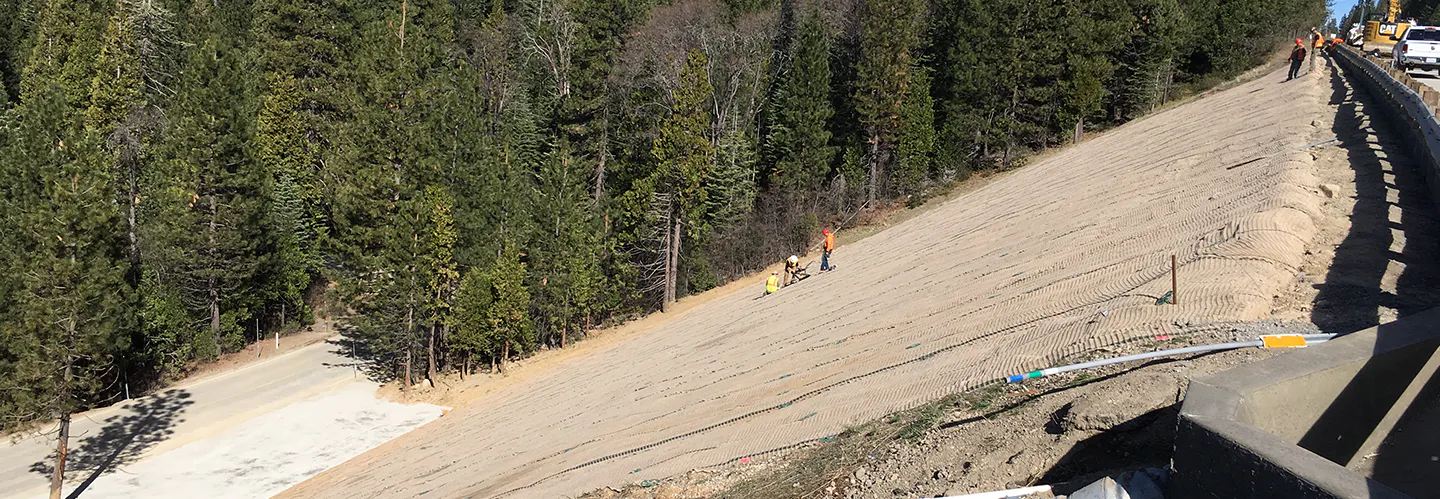
How to stablize transportation infrastructure with minimal carbon impact
The California Department of Transportation (Caltrans) needed to secure a steep slope between an interstate and a maintenance station. This slope stood at 70 feet (21.3 m) high with gradients ranging from 1.7H:1V to 1H:1V. Although a 20-foot (6.1 m) portion at its top had been reinforced with geosynthetic materials, the unprotected part suffered shallow failures around 3.5 feet (1.07 m) deep due to various factors. Caltrans was worried this would compromise both the interstate and the maintenance road.
To address this, the PROPEX® Armormax® Engineered Earth Armoring System was employed. It's composed of PROPEX Pyramat® 75 High-Performance Turf Reinforcement Mat (HPTRM) anchored using corrosion-resistant six-foot (1.83 m) and nine-foot (2.74 m) Engineered Earth Anchors. This setup ensures up to 75 years of erosion protection by holding soil firmly.
Studies revealed that PROPEX Armormax considerably enhanced slope stability by increasing the factor of safety - a ratio defining the balance between forces that resist and initiate slope failure.
PROPEX Armormax has a track record of over ten years in reinforcing embankments and slopes. It's mainly used to safeguard roads but is also viable for railway protection. A significant advantage of PROPEX Armormax is its lower carbon footprint compared to traditional stabilization techniques like rock riprap. For instance, its HPTRM's carbon footprint is 2.7 kgCO2e per square meter (2.7 kgCO2e/10.76 sq ft), a value authenticated by third-party standards. In comparison, concrete alternatives can have up to 10 times higher carbon footprints, and rock riprap up to 30 times.
The reduced carbon footprint of PROPEX Armormax is partly due to decreased transportation needs, slashing transport emissions by around 95%. While rock is natural, its extraction and processing often disregard the environment. On the other hand, PROPEX Armormax is produced in an ISO 14001-certified facility, ensuring an active commitment to minimizing environmental impacts.
Following PROPEX Armormax installation, the slope was vegetated. PROPEX Armormax features a special design promoting rapid root growth, ensuring long-lasting vegetation, reducing sedimentation, and boosting groundwater replenishment. This makes it an Environmental Protection Agency (EPA) recognized Best Management Practice (BMP) for water quality enhancement. In contrast, rock neither supports vegetation nor efficiently filters pollutants.
Explore more blogs
View allHow to combine engineered earth armoring with greywater treatment
Resilient water management by combining greywater recycling with engineered earth armoring for irrigation, erosion control, and increased property value.
How can geosynthetics help energy transition?
Geosynthetics accelerate agricultural outputs and improve resilience by optimizing water management through enhanced irrigation efficiency and providing structural stability to agricultural infrastructures like dams and reservoirs.
How can geosynthetics accelerate agriculture outputs and improve resilience?
Geosynthetics accelerate agricultural outputs and improve resilience by optimizing water management through enhanced irrigation efficiency and providing structural stability to agricultural infrastructures like dams and reservoirs.